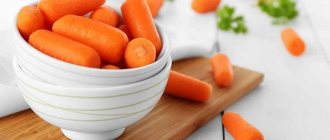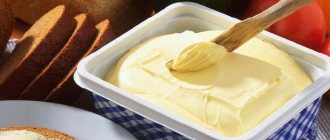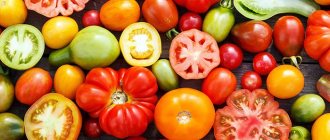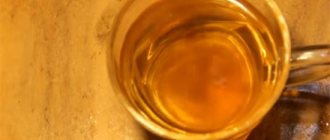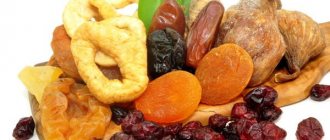03/01/2018 Category: Nutrition for a nursing mother Author: Lyudmila Morozova
Shrimp are popular among gourmets all over the world due to their excellent taste, low calorie content and rich vitamin and mineral composition. This type of seafood is consumed both as an independent dish and as a component for salads, appetizers, and soups. However, the product rightly raises concerns among nursing mothers, because doctors do not give a clear answer to the question of whether shrimp can be consumed while breastfeeding. Despite its high nutritional value, this product can cause allergies, but the reaction is individual for each baby.
- Composition and calorie content of the product
Table: chemical composition and calorie content
- How to choose and cook
Benefits of shrimp
The value of seafood is appreciated by nutritionists - a unique combination of nutrients makes them indispensable in any diet. Shrimp are not only delicious, but also contain:
- iron, which the body needs for normal cellular nutrition;
- zinc, necessary for proper cellular reproduction, stabilizes the genetic structure of cells, promotes the growth of all tissues of the body;
- iodine, without which the normal development of the child’s brain and nervous system, the formation of his intellect, is impossible; its lack causes a decrease in immunity;
- fatty acids necessary for cell reproduction;
- sulfur, which helps strengthen joints and blood vessels, is involved in metabolic processes;
- vitamins A, E, responsible for the level of immunity, hair and skin condition;
- vitamin C, which enhances metabolic processes in the body, as well as its immune defense;
- magnesium – which is needed for the normal functioning of the nervous system;
- phosphorus, potassium, copper, calcium and other valuable substances
Including sea crustaceans in a woman's diet while breastfeeding allows her to;
- maintain efficiency;
- improve the condition of skin and hair;
- strengthen the immune system;
- slow down aging;
- improve the body's hormonal levels;
- prevent the development of anemia.
Valuable iodine-enriched nutrition allows the child’s thyroid gland to function normally, which will ensure the normal development of his intellect and nervous system.
The complete mineral composition of breast milk is the key to the normal development of the baby, especially in the period up to six months of age, when it is the main nutrition for the baby.
Composition and calorie content of the product
It is not recommended for a nursing mother to consume fried shrimp; most of their beneficial properties are lost during the cooking process.
Exquisite taste, varied chemical composition and low calorie content make shrimp a valuable delicacy in the diet of a nursing woman. The meat of these crustaceans contains substances necessary for the full development of the baby and the speedy recovery of the mother after childbirth. Low energy value allows you to include shrimp in the menu without fear of gaining excess weight. The following components stand out most in the product:
- Vitamins A and E ensure beautiful skin and hair.
- Vitamins of group B and PP are necessary for proper metabolism and maintenance of the nervous system.
- The potassium contained in shrimp helps the heart function.
- Iron ensures the necessary level of hemoglobin in the blood.
- Like most seafood, shrimp are high in iodine, which is necessary for the full functioning of the endocrine system.
- Cobalt is involved in the synthesis of amino acids and is necessary for the formation of red blood cells.
- Copper is required for high-quality absorption of iron and is involved in the formation of collagen and elastin in the skin.
- Zinc ensures the formation of bone tissue, stimulates memory and attention, and brain activity.
- Selenium has a positive effect on the condition of the heart, reproductive system, skin, hair and removes mercury from the body.
- Shrimp contain high concentrations of chromium, a trace element involved in carbohydrate and lipid metabolism, which prevents the formation of cholesterol plaques on the walls of blood vessels.
- Calcium and phosphorus are responsible for strengthening bones and tooth enamel.
- Fatty acids are necessary to maintain women's health, regulate hormonal levels, improve brain activity, beautiful hair and skin elasticity.
But the benefits of shrimp are ambiguous when it comes to feeding a nursing mother, because it is a product with a high allergenic status. Shrimp allergy occurs even in adults. Aggressive components can enter the baby’s body along with breast milk, causing allergic reactions or digestive disorders. This property of shrimp is partly explained by the fact that their meat accumulates heavy metals and other chemicals that are present in seawater. If the crustaceans were grown in an artificial freshwater environment, antibiotics and growth hormones used by unscrupulous producers pose a danger.
Table: chemical composition and calorie content
| Nutrient | Quantity | % of the norm in 100 g* |
| Calorie content | 87 kcal | 5.2% |
| Squirrels | 18.3 g | 24.1% |
| Fats | 1.2 g | 2% |
| Carbohydrates | 0.8 g | 0.4% |
| Vitamins | ||
| Vitamin A, RE | 16 mcg | 1.8% |
| beta carotene | 0.01 mg | 0.2% |
| Vitamin B1, thiamine | 0.06 mg | 4% |
| Vitamin B2, riboflavin | 0.07 mg | 3.9% |
| Vitamin B5, pantothenic | 0.26 mg | 5.2% |
| Vitamin B6, pyridoxine | 0.11 mg | 5.5% |
| Vitamin B9, folates | 13 mcg | 3.3% |
| Vitamin B12, cobalamin | 0.8 mcg | 26.7% |
| Vitamin C, ascorbic acid | 1.4 mg | 1.6% |
| Vitamin E, alpha tocopherol, TE | 2.3 mg | 15.3% |
| Vitamin H, biotin | 1 mcg | 2% |
| Vitamin RR, NE | 5 mg | 25% |
| Macronutrients | ||
| Potassium, K | 260 mg | 10.4% |
| Calcium, Ca | 100 mg | 10% |
| Magnesium, Mg | 60 mg | 15% |
| Sodium, Na | 150 mg | 11.5% |
| Sera, S | 210 mg | 21% |
| Phosphorus, Ph | 220 mg | 27.5% |
| Microelements | ||
| Iron, Fe | 2.2 mg | 12.2% |
| Yod, I | 110 mcg | 73.3% |
| Cobalt, Co | 12 mcg | 120% |
| Manganese, Mn | 0.11 mg | 5.5% |
| Copper, Cu | 850 mcg | 85% |
| Molybdenum, Mo | 10 mcg | 14.3% |
| Nickel, Ni | 11 mcg | |
| Fluorine, F | 100 mcg | 2.5% |
| Chromium, Cr | 55 mcg | 110% |
| Zinc, Zn | 2.1 mg | 17.5% |
| Selenium, Se | 41.7 | 76% |
| Fatty acid | ||
| Omega-3 fatty acids | 0.45 g | 50% |
| Omega-6 fatty acids | 0.02 g | 0.4% |
| Monounsaturated fatty acids | 1.06 g | 5.6% |
| Polyunsaturated fatty acids | 0.47 g | 4.2% |
% of the norm in 100 g* - approximate values for a middle-aged nursing woman.
Harm, contraindications for use
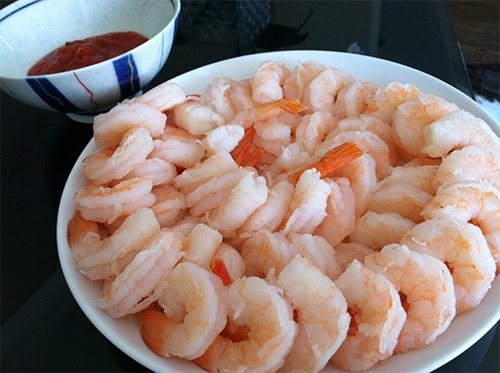
A woman's menu when breastfeeding should include only proven products that do not contain toxic substances. If the quality of potatoes and zucchini grown in your own garden is easy to check, then this is more difficult to do with seafood.
Shrimp tend to absorb all the toxic substances that are in the sea water where they grow, and the level of pollution in the world's oceans is critically high - all heavy metals and radioactive substances are found in marine organisms. The level of mercury found in these organisms is at an all-time high and can be dangerous for nursing mothers.
There are a large number of crustaceans on sale from Southeast Asia, which are grown in unsanitary conditions. To make them grow faster, manufacturers use prohibited hormones and growth stimulating substances, antibiotics and other prohibited components.
Dr. Komarovsky recommends that mothers think about how many times the shrimp was defrosted and frozen before it reached your table.
Unfortunately, it is not always possible to determine the region of origin of seafood, so shrimp should be included in the diet with extreme caution when breastfeeding - they often act as an allergy factor.
Mothers should refrain from experimenting with including shrimp in their menu if the baby is premature or prone to frequent illness.
Harmful effects on the body
Boiled shrimp should not be eaten until the baby is three months old. Accumulated radioactive elements can have a negative effect on the baby's body. Unfortunately, today the environmental situation in each region leaves much to be desired. Conducting experiments on the baby's health condition is not allowed.
Antibiotics and hormones used in artificial cultivation can generally lead to the development of serious pathologies in the baby. Only a limited amount cannot harm. During breastfeeding, you should eat no more than three small pieces.
The main role is played by the reaction of the baby's body. It usually appears within a few days after consumption. Nutritionists recommend abandoning the product if the following negative manifestations are present:
- an abundance of red spots on the skin;
- change in the intensity and general character of stool;
- The baby became nervous and irritable.
It is allowed to eat shrimp in small portions only if there are no negative reactions.

You can make a salad from shrimp
How to choose the best quality product?

If you decide to include shrimp in your diet, a nursing mother needs to take a responsible approach to choosing the product. Seafood must be from a responsible and trusted manufacturer, preferably fresh frozen (canned, boiled-frozen and simply chilled shrimp are on sale). When purchasing, it is advisable to choose a product in transparent packaging through which you can see the contents; you should pay attention to the date of catch.
You should pay attention to the color and appearance of the crustaceans:
- they should be elastic and have a translucent shell;
- shrimp must be whole;
- the tail of the shrimp bent inward indicates their freshness;
- the meat should be white and odorless - yellow meat indicates a spoiled product;
- spots on the body of the crustaceans indicate low quality shrimp;
- black spots on the head indicate the unsuitability of the product, its repeated defrosting and re-freezing.
The best shrimp are those caught by the Danes, Lithuanians or Norwegians. They are small because they grew up in cold waters, not very presentable, but tasty and of high quality.
Large specimens grow in warm southern seas and are supplied from Vietnam, China, Brazil and Ecuador. These are tiger and king prawns - they are large, but not so tasty. Experts recommend seafood produced in Latin American countries - they have high production standards.
How to eat shrimp correctly during lactation
The use of the product must be carried out taking into account certain rules:
- Use fresh frozen crustaceans. Appearance will ensure the quality of the product;
- Carefully study information about the manufacturer, release date;
- Give preference to manufacturers from Denmark, Lithuania, Canada, Latin America, Norway;
- Avoid buying crustaceans with black heads. The product may be spoiled and pose a health hazard;
- The green color of the heads indicates that the crustacean is consuming natural food;
- Prepare the product with a minimum amount of salt and spices;
- Use a limited amount of the product in your diet.
How to introduce it into the diet?
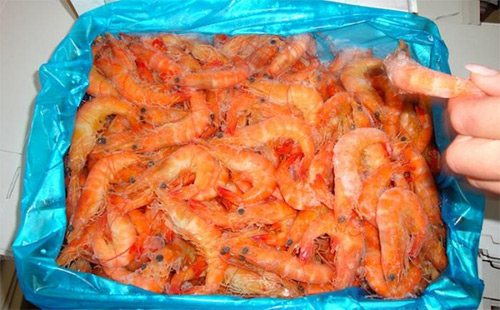
If, nevertheless, a woman decides to introduce shrimp into her diet, several conditions must be met:
- the child must be at least six months old;
- fresh product should be cooked with a small amount of salt;
- eat 2-3 shrimps in the morning;
- Monitor the child for 48 hours.
The allergy will manifest itself:
- hives;
- unreasonable crying and sleep disturbances;
- difficulty breathing;
- vomiting;
- bloating;
- stool disorder.
If the slightest sign of intolerance appears, you should refuse shrimp and try again after the child is weaned.
Recommendations
Freshly frozen shrimp are boiled in lightly salted water. There are many recipes that call for frying shrimp. But like any fried food, they will not be beneficial for the mother and child in this form. A nursing mother should not exceed the shrimp consumption rate: 100 g per week.
A nursing woman should introduce shrimp into her diet gradually, like any new food. First, you should try a couple of shrimps and observe the baby’s reaction for a couple of days. If there is no redness, diarrhea or other alarming symptoms, you can try increasing the portion of the treat. However, you should not overuse this seafood.
Is it possible to eat in the first month of a child’s life?
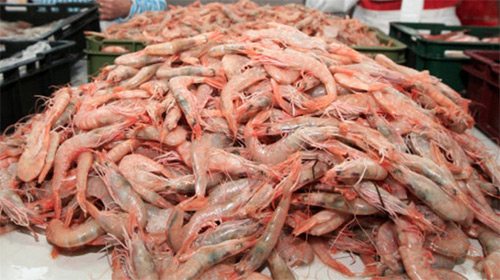
During the first three months after birth, a newborn child adapts to independent feeding. His intestines become colonized with beneficial microorganisms, which causes intestinal colic.
Pediatricians recommend that nursing mothers include safe vegetable and cereal dishes, milk porridge and cottage cheese in their diet during this period. The diet should be expanded carefully so as not to harm the child.
Shrimp is not a product necessary for good lactation. At the same time, this type of seafood is a strong allergen, so there is no point in risking the health of the newborn.
Feedback from nursing mothers
I order rolls from time to time, everything seems to be good, but they also have shrimp and more
zheny
https://www.u-mama.ru/forum/kids/0–1/193566/
Sometimes I only ate them. until the child gets out of hand: you pour a few pieces into a bowl, pour boiling water from the kettle - and now you won’t faint from hunger)))
State Secret
https://www.u-mama.ru/forum/kids/0–1/193566/
In general, seafood is an allergen, but exactly how your baby will react can only be known through experience. Try a few things first, rather than a whole plate, so that if anything happens, the consequences are minimal.
*koza*
https://www.u-mama.ru/forum/kids/0–1/193566/
I ate a lot - but the first time, of course, a little.
Twin
https://www.u-mama.ru/forum/kids/0–1/193566/
This is a very strong allergen. I wouldn't eat.
Katy
https://www.baby.ru/blogs/post/46573782–33597392/
How to boil correctly?
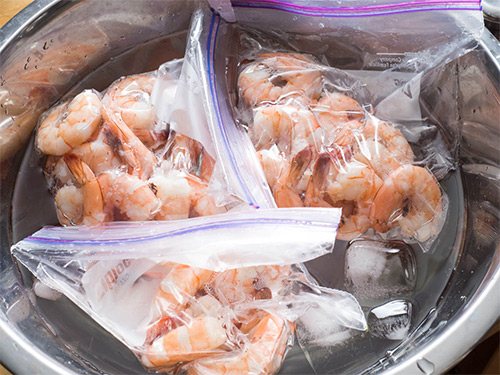
It is better for a woman who is breastfeeding to consume chilled or freshly frozen seafood. They need to be cooked quickly; the overcooked product loses its quality - it becomes rubbery and tasteless. Small shrimp should be cooked in salted boiling water for no more than two minutes, large ones – a minute longer.
To boil shrimp you need:
- rinse seafood well under running water;
- the amount of water in the cooking pan should be 2 times the amount of seafood;
- salt the water and squeeze half a lemon into it;
- Boiled shrimp float to the surface when ready.
Cooked seafood is removed from boiling water, sprinkled with lemon juice and olive oil.
Recipes with shrimp for nursing
There are a large number of recipes for dishes with shrimp, but for a nursing woman it is better to use more nutritious first or second courses.
Cream soup
To prepare the puree soup you need:
- shrimp – 100 grams;
- 2-3 medium potatoes;
- 1 processed cheese;
- 1 small zucchini;
- 1 tablespoon butter;
- medium carrot;
- small onion;
- a little dill;
- 1 tsp. lemon juice;
- salt and sugar.
You need to cook in 2 pans - boil the shrimp separately, cook the vegetables separately. To prepare, you need to thoroughly rinse and peel the vegetables, carefully cut into small pieces. Boil vegetables in 1.0 liter of water until tender.
Add some of the butter and processed cheese to the vegetable mixture and beat with a blender until pureed. Lightly fry the cooked shrimp in a small amount of oil, divide into pieces and add to the soup. Garnish with fresh herbs.
Pilaf
Pilaf is prepared quickly and easily in a slow cooker. To prepare you need:
- 200 grams of shrimp;
- one medium onion;
- one carrot;
- ¾ cup long grain rice;
- 3 tablespoons vegetable oil;
- salt and pepper to taste, bay leaf.
To prepare, you need to peel and chop the vegetables and remove the shells from the shrimp. Place the vegetables in the multicooker bowl, pour in the oil and cook in frying mode for 5 minutes. Add shrimp and fry for 5 minutes. Pour rice washed in several waters into a bowl, add 400 grams of water, and cook in Pilaf mode for 35-40 minutes.
Shrimp is a healthy and tasty product that should be included with extreme caution in the menu of nursing mothers.
What can you eat

There is such a simple sign of what you can and cannot eat from foods:
| Products | Can | Prohibited/allowed in small doses |
| Vegetables | Heat-treated - stewed, boiled, baked. Freshly squeezed juices after 1 month, fresh after 3 months. Carrots, cauliflower, potatoes, zucchini, eggplant, zucchini. | Fresh, fried, overseas vegetables. Garlic, onion, white cabbage, tomatoes, cucumbers, radish, radish |
| Fruits | Bananas, apples and pears, baked without skin, peaches, plums. Freshly squeezed juices after 1 month | Exotic fruits, any berries (especially raspberries, strawberries), grapes, citrus fruits, mango, papaya |
| Meat | Eat without combining it with anything. No side dish. Low-fat varieties - turkey, rabbit, beef, lean pork, skinless chicken. Cooking: steam, boil, stew, bake | Smoked, fried, dried, fatty broths |
| Fish | Sea, river. Low-fat. Cooking: steam, boil, stew, bake | Red fish, shrimp, crayfish, caviar. Sun-dried, smoked, salted fish |
| Cereals | Any, especially: buckwheat, rice, oatmeal. Cook: with milk, water | Semolina, instant porridge. |
| Dairy products | Milk, kefir, fermented baked milk, yogurt, cottage cheese. Everything is not too greasy | Fatty or low-fat products, sour cream in large quantities |
| Pasta | Better from corn, buckwheat or rice flour | With cheese and lots of butter |
| Eggs | Boiled quail, chicken 1 pc. in a day | |
| Bread | Yesterday's rye-wheat with bran in small quantities, dry cracker | Fresh, hot |
| Fats | Cold pressed vegetable oils, butter | Refractory fats |
| Sweet | Cookies, marmalade, marshmallows, marshmallows, dried fruits, biscuits. After 1 month - jam | Honey, chocolate, large quantities of confectionery fat (creams, whipped cream) |
| Beverages | Dried fruit compote, herbal teas (with mint, thyme, oregano), green tea, still mineral water | Black tea, coffee, soda, packaged juices, berry and fruit juice |
Based on the table, after the first month you can slowly add prohibited foods. Observe the child's reaction. Add lean borscht and low-fat sour cream to your diet. Slowly add nuts other than peanuts. Carefully monitor the newborn's reaction: for colic, rashes and other negative symptoms. To understand which product may cause a negative reaction, you need to introduce them one at a time and gradually.
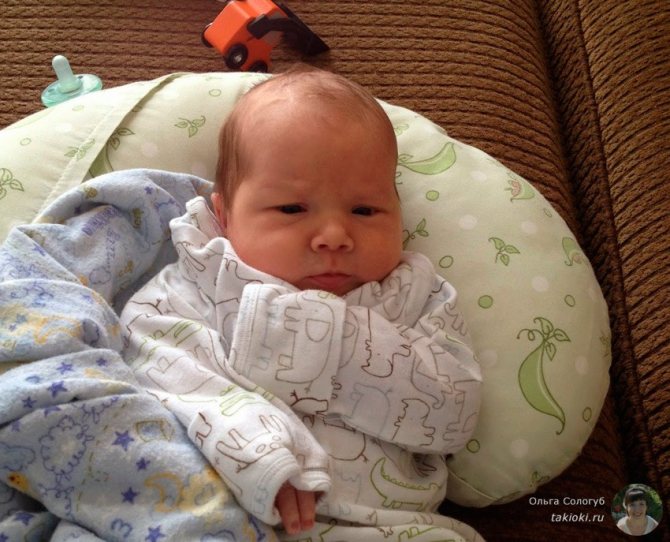
You can start eating some forbidden food once every two days and watch the baby’s reaction. Although this is all individual. Some people start eating strawberries or coffee a little from the first days. But again, I repeat, in small quantities.
All the following foods should be excluded from the first days of pregnancy. Maybe I’ll repeat myself somewhere, but it’s strictly forbidden:
- Alcohol
- Chocolate
- Coffee
- Semi-finished products
- Sausages, ham, sausage
- Spicy, fried, salted, pickled, canned
- Fatty fish, meat, lard
- Sulguni cheese
- Legumes
- Sauerkraut
- Peanut
- Products with flavoring additives, dyes, preservatives
- Hot, hot spices and seasonings
- Large amounts of salt and sugar
- Unnatural sauces, mayonnaise, ketchup
